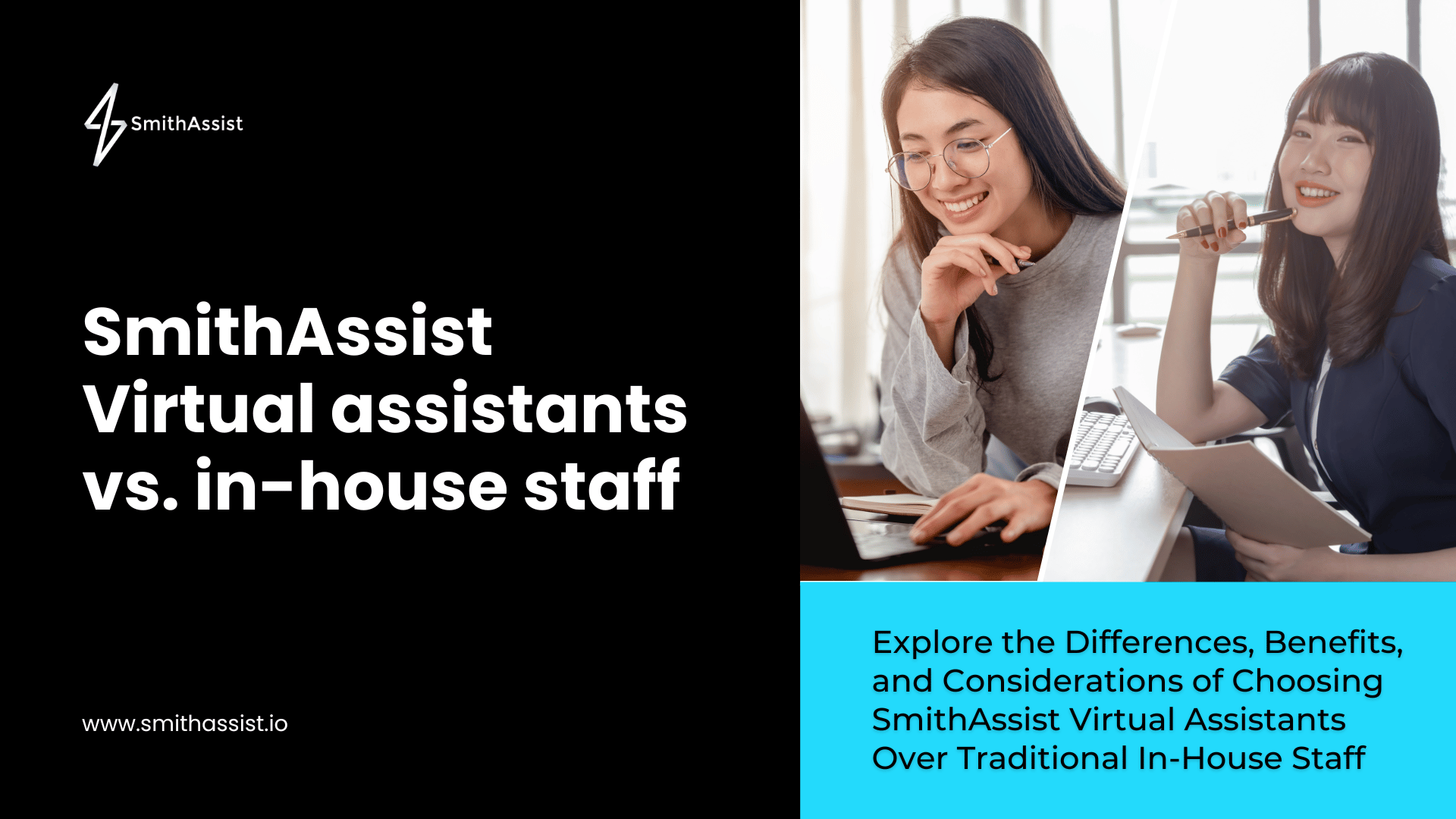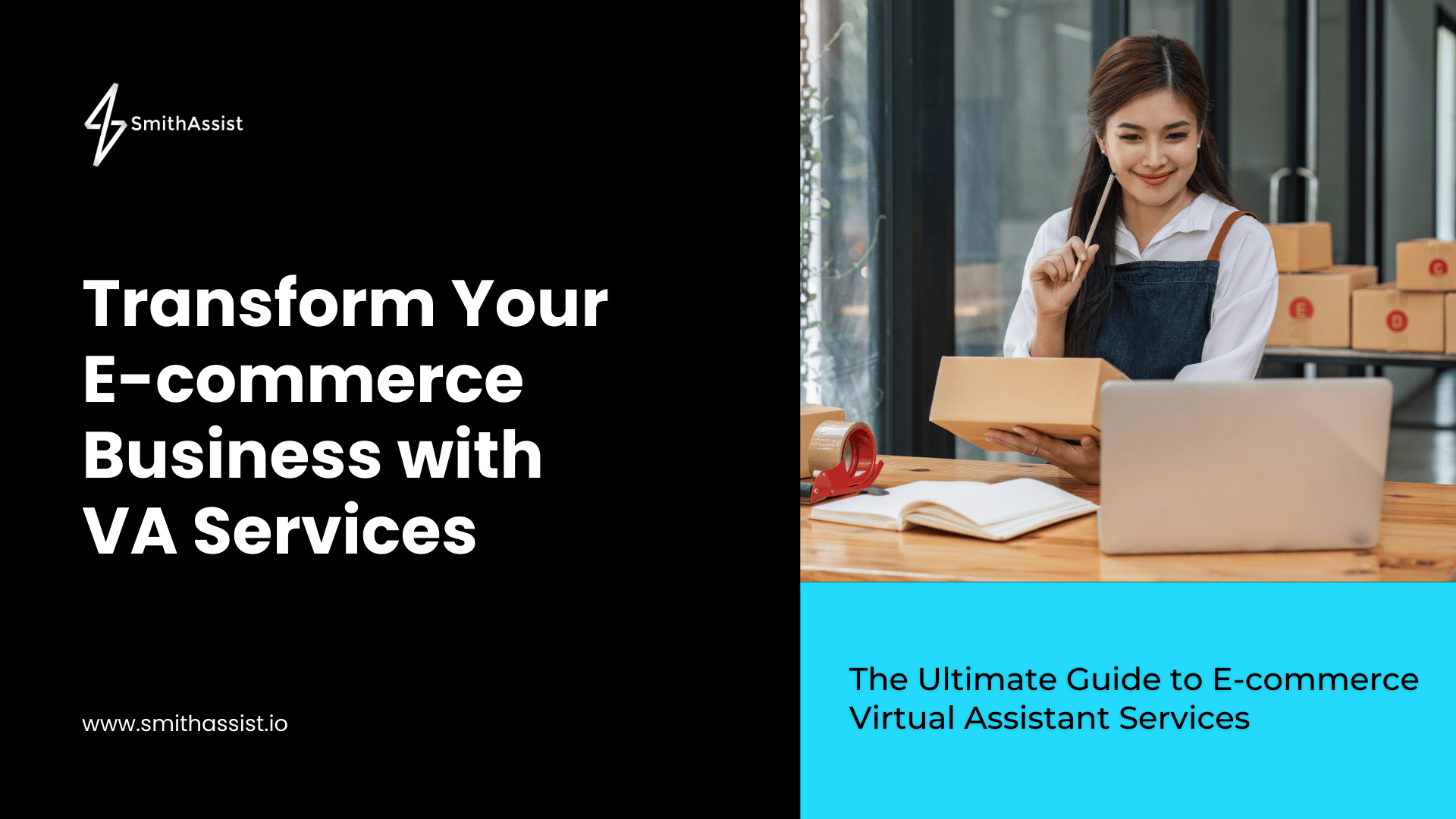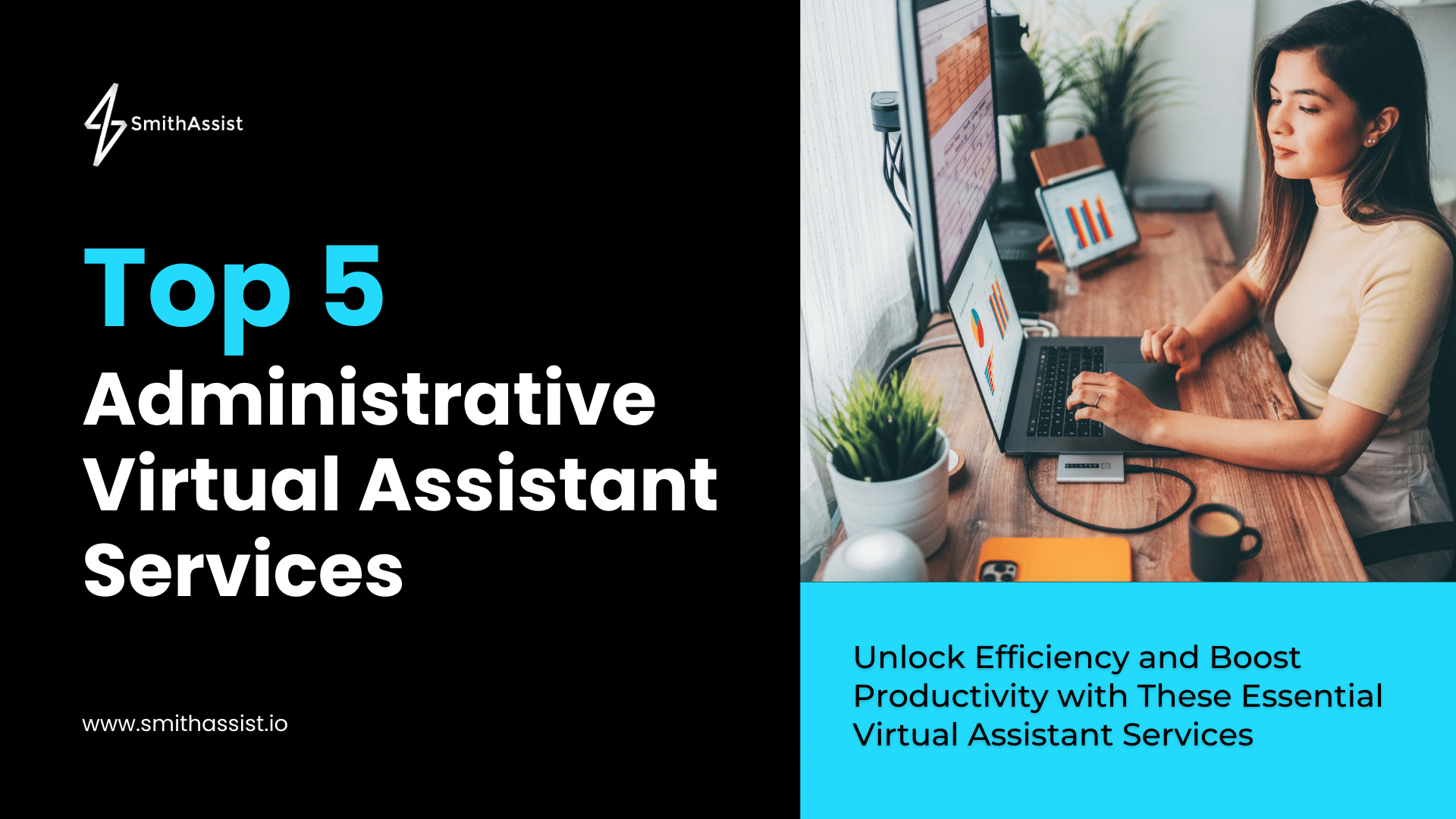Boost Your Productivity with a Virtual Assistant: Ways a VA Can Help
Finding ways to boost productivity is essential to stay competitive. One highly effective strategy is to hire a virtual assistant. Virtual assistants...
9 min read
SmithAssist Marketing : Jul 4, 2024 11:15:09 AM

The decision between hiring a virtual assistant (VA) and an in-house employee can greatly influence your organization’s efficiency and budget. With remote work on the rise, knowing the benefits of virtual assistants is essential for businesses of all sizes. In this blog, we’ll explore the differences between virtual assistants and in-house staff to help you decide which option is best for your business. VAs handle a variety of tasks, from administrative duties to customer service, all managed remotely through digital tools. Their flexibility and access to a global talent pool make VAs a smart choice for many companies.
TL;DR: Virtual assistants provide remote support for various tasks, using technology to offer flexible and efficient services. They help cut costs by eliminating the need for office space and full-time employee benefits. Let's learn the differences between virtual assistants and in-house staff, helping you decide which option is best for your business.
A virtual assistant (VA) provides various services to businesses and entrepreneurs remotely, such as administrative tasks, customer service, social media management, scheduling, and data entry. Unlike traditional staff, VAs work independently using digital tools and communication platforms to manage their duties without being in the office. This remote capability broadens the talent pool and offers flexibility in work hours and project scalability.
The growth of virtual assistants is driven by technological advancements that enable seamless communication and collaboration globally. VAs use video conferencing, cloud storage, project management software, and instant messaging to stay in constant contact with clients and ensure smooth task execution. This technology allows VAs to deliver services comparable to in-house staff, often with greater efficiency and adaptability.
Hiring a VA can lead to significant cost savings. Businesses can hire VAs on a part-time, full-time, or project basis, avoiding overhead costs associated with full-time employees, such as office space, equipment, and benefits. Additionally, since VAs often work as independent contractors, companies aren't responsible for payroll taxes or other employment-related expenses. This financial flexibility, combined with access to a global talent market, makes VAs an attractive option for optimizing operations and reducing costs.
Comparing virtual assistants to in-house employees highlights several key differences that impact how businesses operate and manage their workforce. The most notable distinction is the work environment. In-house employees work onsite, facilitating direct, face-to-face interactions and immediate access to resources and colleagues. Virtual assistants, on the other hand, work remotely, relying on digital communication tools. This remote model offers flexibility and can enhance productivity, as VAs can manage their own schedules and work from any location.
Cost structure is another critical difference. In-house staff come with significant overhead costs, including office space, utilities, equipment, and employee benefits like health insurance and retirement plans. Virtual assistants, usually independent contractors, cover their own expenses and benefits, allowing businesses to save on these overheads. This cost-effectiveness is especially beneficial for small businesses and startups with tight budgets.
Flexibility and scalability also set virtual assistants apart. VAs can be hired on an as-needed basis for short-term projects, part-time work, or full-time support, allowing businesses to adjust their workforce according to demand without the long-term commitment required for in-house staff. In contrast, in-house employees offer deep integration into company culture and consistent presence, which is crucial for roles needing close collaboration and a thorough understanding of company operations.
When deciding whether to hire a virtual assistant (VA) or an in-house staff member, consider the pros and cons of each option. One major advantage of hiring a VA is cost savings. VAs are often more cost-effective than full-time employees since you only pay for the hours you need and avoid overhead costs like office space and benefits.
Flexibility is another benefit of VAs. They can work on a project basis or provide ongoing support, allowing you to scale your team up or down as needed. This is useful for businesses with fluctuating workloads or seasonal demands. Additionally, VAs provide access to a wider talent pool, enabling you to find individuals with specialized skills not available locally, which is beneficial for tasks requiring niche expertise.
VAs can also boost productivity by handling administrative tasks, freeing up your time for core business activities and strategic initiatives. Without the need for office space or equipment, you further reduce overhead costs.
However, hiring a VA has potential drawbacks. Communication challenges can arise with remote team members, making it harder to monitor their work and ensure task completion. Security and confidentiality concerns may also be an issue when sharing sensitive information with a VA, especially if they are in a different country. Cultural differences might also affect collaboration.
Integrating a VA into your workflows may require additional time and effort for onboarding and training, which can be more challenging than with an in-house employee.
Consider your specific business needs, the nature of the tasks, and your budget when deciding between a VA and an in-house staff member. Weighing the pros and cons will help you make an informed decision that aligns with your company's goals and objectives.
When deciding between hiring an in-house employee or a virtual assistant, it's important to consider the pros and cons of each option. In-house employees offer the benefit of direct supervision, ensuring tasks are completed to your standards. They provide a personal touch and face-to-face interaction, which can strengthen company culture. Additionally, in-house employees often demonstrate greater loyalty and commitment since they are physically present and more invested in the company's success. They may also be better suited for tasks requiring specialized skills.
However, in-house employees come with higher costs due to office space, equipment, benefits, and other overhead expenses. Their set work hours may limit availability outside of business hours, which can be a disadvantage if you need assistance during non-business hours or weekends. Moreover, you are limited to the local talent pool, which might not always have the specific skills or experience you need.
On the other hand, virtual assistants are often more cost-effective as you only pay for the hours worked and avoid overhead costs. They offer flexibility, allowing you to scale your team up or down as needed, and provide access to a global talent pool with specialized skills. Virtual assistants can also enhance productivity by handling administrative tasks, freeing up your time for core activities. However, remote work can lead to communication challenges and difficulties in monitoring work. There are potential security and confidentiality concerns when sharing sensitive information, and cultural differences may affect collaboration. Additionally, integrating a virtual assistant into your workflows may require extra time and effort for onboarding and training.
Hiring a virtual assistant is particularly beneficial when your business experiences a surge in workload but lacks the resources to hire additional full-time staff. This is common for startups, small businesses, and entrepreneurs who need to manage operational costs carefully. Virtual assistants provide the necessary support without a long-term financial commitment, allowing businesses to scale operations quickly and efficiently. They handle tasks such as administrative duties, customer service, and social media management, enabling you to focus on core business activities and strategic growth.
Virtual assistants are also ideal when specialized skills are needed for specific projects or tasks. Many VAs have diverse backgrounds and expertise in areas like marketing, graphic design, IT support, and content creation. Hiring a VA with the right skill set provides access to professional services that might not be available within your current team, ensuring high-quality outcomes and saving time and resources on training in-house employees.
If your business operates in a dynamic environment with fluctuating demands, a virtual assistant offers the flexibility to adapt quickly. Unlike in-house staff, VAs can be engaged on a short-term or project-by-project basis, making it easy to scale up or down as necessary. This adaptability is especially valuable during peak seasons, product launches, or other periods of increased activity. Leveraging the services of a virtual assistant helps maintain productivity and efficiency without the constraints of traditional employment models, ensuring your business remains agile and responsive to changing needs.
Hiring an in-house employee is often the best choice when the role requires deep integration into the company's culture and day-to-day operations. Positions that demand constant collaboration, immediate access to resources, or a thorough understanding of the company's internal processes are typically better suited for in-house staff. For instance, roles in management, human resources, and certain technical positions benefit from the direct, face-to-face interaction that only in-house employment can provide. These employees can attend regular meetings, participate in spontaneous brainstorming sessions, and build stronger interpersonal relationships with their colleagues.
In-house employees are also essential when the job involves handling sensitive information or proprietary technology that requires a high level of security and control. Having staff on-site allows businesses to implement more stringent security measures and maintain closer oversight of their work. This is particularly important for industries such as finance, healthcare, and technology, where data privacy and security are paramount. Additionally, in-house employees can quickly respond to any issues that arise, ensuring that critical tasks are completed efficiently and securely.
Another key consideration for hiring in-house employees is the need for consistency and long-term commitment. In-house staff provide a stable, reliable workforce fully invested in the company's mission and goals. They are more likely to develop a sense of loyalty and dedication to the organization, which can result in higher productivity and morale. Furthermore, in-house employees can take on multiple responsibilities and grow within the company, providing a strong foundation for future leadership and continuity. This stability is crucial for businesses looking to build a cohesive, dedicated team that can drive long-term success and innovation.
When deciding between a virtual assistant and an in-house employee, cost is a significant factor. Hiring in-house staff generally incurs higher expenses, including salaries, benefits, office space, equipment, and other overhead costs. These expenses can quickly add up, making in-house employees a substantial investment, particularly for small businesses or startups with limited budgets. Additionally, costs associated with recruiting, training, and retaining employees further increase the financial burden.
In contrast, virtual assistants offer a more cost-effective solution. Since VAs work remotely, businesses do not need to provide office space, equipment, or utilities. Virtual assistants are typically independent contractors, so companies are not responsible for providing benefits such as health insurance, retirement plans, or paid time off. This arrangement allows businesses to pay only for the hours worked or specific tasks completed, offering greater flexibility and control over their budget. By reducing overhead and eliminating the need for long-term financial commitments, hiring a virtual assistant can lead to significant cost savings.
Moreover, the financial flexibility of virtual assistants enables businesses to scale their workforce up or down based on demand. This adaptability is particularly advantageous during periods of growth or when handling temporary projects. Businesses can hire virtual assistants on a part-time, full-time, or project-specific basis, ensuring they only pay for the services they need. This approach not only optimizes resource allocation but also allows companies to access a diverse talent pool without the geographical constraints associated with in-house employees. Ultimately, the cost comparison between virtual assistants and in-house staff highlights the potential for substantial savings and increased financial efficiency with the former.
Both virtual assistants and in-house employees offer unique strengths that benefit different business aspects. In-house employees excel in roles requiring constant collaboration, immediate feedback, and direct supervision. Their physical presence fosters spontaneous communication and quick problem-solving, contributing to a cohesive team environment. This direct interaction is crucial for tasks demanding close teamwork and real-time decision-making, ensuring smooth and efficient project progression.
Virtual assistants, however, provide a different productivity advantage through flexibility and specialized skills. Since VAs manage their schedules and work remotely, they can maintain high productivity levels without typical office distractions. Many virtual assistants are experts in their fields, offering specialized services that enhance efficiency for specific tasks. This expertise allows businesses to delegate tasks to the most qualified individuals, ensuring high-quality results. Additionally, the remote nature of VAs allows work to continue beyond regular office hours, accommodating different time zones and urgent project needs.
Another key productivity benefit of virtual assistants is the ability to quickly scale resources according to business demands. During peak times or special projects, businesses can easily increase their VA workforce without the delays associated with traditional hiring processes. This scalability ensures high productivity even during periods of increased workload. Conversely, in-house employees, while consistent and reliable, may face challenges in rapidly adjusting to fluctuating business needs.
Deciding between hiring a virtual assistant or an in-house employee hinges on understanding your business's specific needs and dynamics. For companies prioritizing flexibility and cost-effectiveness, virtual assistants are often the ideal solution. VAs offer specialized skills on a scalable basis, enabling businesses to adapt quickly to changing demands without the long-term financial commitment of full-time employees. This approach is particularly well-suited for startups, small businesses, or organizations with fluctuating workloads that require occasional expert support without incurring significant overhead costs.
Conversely, in-house employees may be a better fit for roles requiring deep integration into the company culture and consistent, day-to-day collaboration with other team members. Positions involving strategic planning, management, or tasks benefiting from regular, face-to-face interactions often necessitate an in-house presence. In-house staff can develop stronger relationships within the team, contribute to a cohesive work environment, and provide continuity vital for long-term projects and initiatives. This integration is crucial for maintaining a unified company vision and ensuring all team members align with organizational goals.
Ultimately, the choice between a virtual assistant and an in-house employee should be guided by a thorough assessment of your business’s operational needs, budget constraints, and long-term objectives. Consider the nature of the tasks, the level of expertise required, and the desired level of interaction with your team. By carefully evaluating these factors, you can determine which type of worker will provide the most value and contribute effectively to your business's success. In some cases, a hybrid approach may be best, leveraging the strengths of both virtual assistants and in-house employees to create a versatile and dynamic workforce.
Determining whether to hire a virtual assistant or an in-house employee is crucial for your business's efficiency, cost management, and overall success. Virtual assistants offer flexibility, cost savings, and access to specialized skills, making them ideal for businesses with fluctuating workloads or specific project needs. In contrast, in-house employees provide deep integration into company culture, direct supervision, and a stable presence essential for roles requiring close collaboration and long-term commitment. By thoroughly assessing your business's unique requirements, you can determine the right fit that will help drive your organization toward its goals and ensure sustainable growth.
Unlock your business's potential with SmithAssist. Our virtual assistants streamline essential tasks, boosting efficiency and fueling growth. Reclaim valuable time and peace of mind while we handle the details. Experience the transformation with SmithAssist, allowing you to focus on what truly matters.

Finding ways to boost productivity is essential to stay competitive. One highly effective strategy is to hire a virtual assistant. Virtual assistants...

An ecommerce virtual assistant (VA) is a valuable asset for online businesses seeking to streamline operations and drive growth. These skilled...

Managing an ever-increasing list of routine tasks can drain valuable time and resources from your core business operations. Did you know that 67% of...